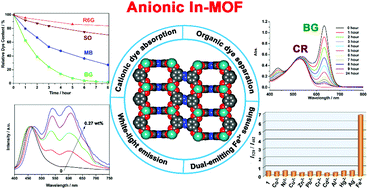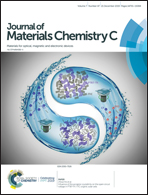Multifunctional anionic indium–organic frameworks for organic dye separation, white-light emission and dual-emitting Fe3+ sensing†
Abstract
Two microporous anionic indium-based metal–organic frameworks, namely [Me2NH2][In(abtc)]·solvents (1) and [Me2NH2][In(bptc)]·solvents (2) (H4abtc = 3,3′,5,5′-azobenzenetetracarboxylic acid; H4bptc = biphenyl-3,3′,5,5′-tetracarboxylic acid), have been synthesized and characterized. Single-crystal X-ray analyses show that compounds 1 and 2 display isostructural three-dimensional anionic frameworks with PtS topology. With these structural features, both compound 1 and compound 2 can selectively separate cationic organic dyes with suitable size. White-light emission can be obtained by loading compound 2 with safranin O. In addition, compound 1 dispersed in dimethyl formamide not only retains the emission of the abtc4− ligand at about 402 nm, but also gives new emission centered at 623 nm. Based on these emissions, compound 1 was developed as an efficient dual-emitting sensor for probing Fe3+ ions.



 Please wait while we load your content...
Please wait while we load your content...